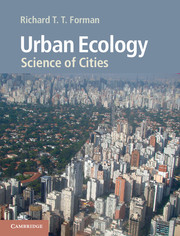Book contents
- Frontmatter
- Dedication
- Contents
- Foreword
- Preface
- Acknowledgments
- Part I Framework
- Part II Ecological features
- 4 Urban soil and chemicals
- 5 Urban air
- 6 Urban water systems
- 7 Urban water bodies
- 8 Urban habitat, vegetation, plants
- 9 Urban wildlife
- Part III Urban features
- Epilogue
- Appendix A Positive and negative attributes of an urban region
- Appendix B Equations
- References
- Index
4 - Urban soil and chemicals
Published online by Cambridge University Press: 05 June 2014
- Frontmatter
- Dedication
- Contents
- Foreword
- Preface
- Acknowledgments
- Part I Framework
- Part II Ecological features
- 4 Urban soil and chemicals
- 5 Urban air
- 6 Urban water systems
- 7 Urban water bodies
- 8 Urban habitat, vegetation, plants
- 9 Urban wildlife
- Part III Urban features
- Epilogue
- Appendix A Positive and negative attributes of an urban region
- Appendix B Equations
- References
- Index
Summary
The nation that destroys its soil destroys itself.
Franklin D. Roosevelt, letter to the governors, 26 February 1937… microwildernesses exist in a handful of soil … close to a pristine state and still unvisited. Bacteria, protistans, nematodes, mites, and other minute creatures … A lifetime can be spent in a Magellanic voyage around the trunk of a single tree.
Edward O. Wilson, Naturalist, 1994The essence of urban soil
Soil is the source of life. We build on soil, and nations rise and fall on their soil. Look closely and wondrous organisms appear, upon which we depend. In urban areas hard surfaces covering so much of the ground render much of the soil invisible. Consequently the remaining greenspaces and spots are that much more valuable for life and us. Most of the species central to urban ecology – trees and shrubs and flowers and wildlife and soil animals and soil microbes and us – depend on these remnant magical spaces.
Geologists, engineers, and land planners usually consider “soil” to be all the loose unconsolidated earth material (regolith) above the bedrock, thus focusing on the mineral component (Berke et al., 2006; Marsh, 2010). In contrast, most agriculturalists and soil scientists consider “soil” to be the upper portion of this unconsolidated material that is modified by the biological activity of abundant microbes, soil animals, and plant roots. Both perspectives are important in urban ecology.
- Type
- Chapter
- Information
- Urban EcologyScience of Cities, pp. 91 - 124Publisher: Cambridge University PressPrint publication year: 2014
- 1
- Cited by

